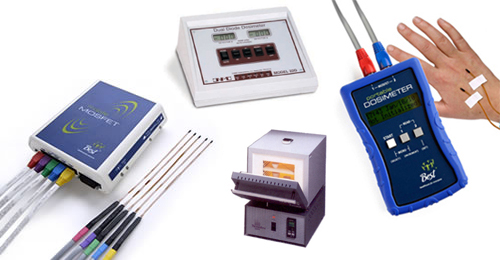
Dose Monitors
Please click the product you want to learn more about:
Diode Dosimeters
Model 22D
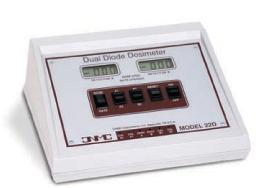
Dual Diode Monitor
The CNMC Model 22D is a compact, economical, battery-operated dual-channel diode monitor designed for simplicity of operation without compromising accuracy and reliability.
The user-friendliness of the Model 22D is immediately apparent by its sloping control panel that allows operation from a convenient angle. Collected exposure data from both channels is read simultaneously on two large, easy-to-read liquid crystal displays without switching. Two independent calibration potentiometers for each channel allow individual custom calibration settings for up to two sets of diode detectors or two beams.
Operation of the 22D is simple. Only four switches are needed to select the calibration factors and dose-to-dose rate and to reset the display to zero. It is powered by a single, readily-obtainable, easily-accessible 9-volt battery. An input jack is provided for the UL-listed wall-mount transformer in case AC line operation is desired.
A special inherent feature of the Model 22D is its compatibility with both negative and positive current output diode detectors: EquiDose® II, Isorad, QED or VeriDose. This flexibility allows utilization of all existing diode detectors and future standardization. When using with detectors that have a 2 or 3 meter cables, one extension cable of suitable length is needed per channel.
EquiDose® II Diode Detectors
Solid state diode detectors are available to satisfy a wide range of photon and electron energies. Representing the state-of-the-art in diode dosimetry, EquiDose® II detectors feature high impedance, excellent linearity and directional response, plus a low temperature coefficient.
MOSFET Dosimetry
MobileMOSFET
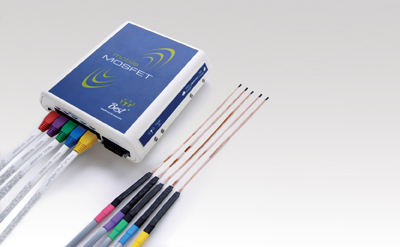
Wireless Dose Verification System
The mobileMOSFET dose verification system (TN-RD-70-W) takes MOSFET dosimetry to the next level.
The mobileMOSFET is a portable, easy-to-use, seamlessly integrated system that simplifies dosimetry and minimizes QA time, making it ideal for a busy radiotherapy center. For example, one Reader Module can be easily shared between multiple treatment rooms (with LAN connections and additional transceivers).
This new wireless system is entirely software driven, allowing for remote control of one or more systems from a PC. The system consists of Remote Monitoring Dose Verification Software, wall-mounted Bluetooth™ Wireless Transceiver and a small Reader Module that acts as a channel between the MOSFET and software, providing a final dose report for patient records. Up to five MOSFETs or one Linear 5ive Array can be plugged into one module. This provides easy mobility within the treatment room. The PC is online with the Reader Module and the dose is obtained in real time.
Portable Dosimeter

The Portable Dosimeter, model TN-RD-90, is an economical, compact, stand-alone system for radiation dose measurement.
Patient dosimetry measurements are available at the touch of a button and display on the integrated LCD, without the need for software or a computer. Additionally, the rechargeable battery powered dosimeter allows easy transportation from room-to-room, or hospital-to-hospital.
The Portable Dosimeter supports up to two simultaneous dose points with any of the Best Medical Canada single MOSFETs on standard or high bias setting for optimal dose reproducibility. An automatic mode is available to continuously sample dose data at a fixed time interval during a session.
After every measurement the dosimetry data is automatically stored to memory for later viewing and can be downloaded to a computer via a USB connection and the PortableDose Connect software. A simple, menu driven interface allows customization of calibration factors, dose units and operational settings directly on the Portable Dosimeter. To save you time, a library of default calibration factors is stored in the memory, but the user also has the choice of entering their customized calibration factors.
Radiotherapy clinics can utilize the Portable Dosimeter for patient dose QA, or to measure exposures to regions-at-risk. In diagnostic radiology, the system is ideal for residual exposure dose measurements, and protocol evaluation.
For one-to-two dose points, the Portable dosimeter is a fast, simple solution for patient dosimetry that can be used for a wide range of applications in radiotherapy and radiology.
- Stand-alone reader with LCD
- Portable and compact
- Quick set-up time
- Simple menu operation
- Supports two MOSFET dosimeters
- Supports all single Best Medical Canada MOSFETs
- Optional data export via USB and PortableDose Connect software
- Calibration factor library
- Long rechargeable battery life
- Manual measurement mode, or Automatic Sequential mode
- No software or computer necessary
- In vivo dose – photon or electron
- Skin entrance and exit dose (TBI)
- Dmax dose measurements
- IMRT and Tomotherapy
- Brachytherapy
- Pediatric CT dose
- Fluoroscopy dose
Linear 5ive MOSFET Array
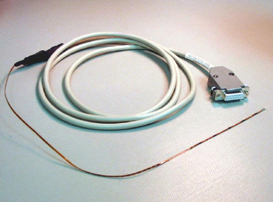
Dosimeter
The Linear 5ive MOSFET Array for Radiotherapy applications is ideal for LDR/HDR Brachytherapy and IMRT QA. It is compatible with the mobileMOSFET. The Array contains five isotropic, energy independent MOSFET dosimeters at 2cm intervals. The MOSFETs on the array can be read simultaneously, facilitating multiple dose measurements at several spatial points. The radio-opaque marker, located at the tip of the array, enables visualization under X-ray imaging including CT and Fluoroscopy, allowing for 5 dosimetry points to be accurately located and easily compared to the target doses.
The isotropic Linear 5ive Array, with excellent reproducibility and linearity, is the tool of choice for a variety of radiotherapy applications such as in-vivo dosimetry and Beam Quality Assurance.
The array can be used effectively for direct measurement of intracavitary dose profiles. During gynecological and prostate procedures, five dose points can be read directly from a computer, displaying the dose profile of the organ at risk in real-time. This is then compared to the planned target dose, allowing for immediate assessments of post-implant base and apex dose, as well as the dose to the organs at risk (eg. urethra, rectum or bladder).
Two arrays crossing at the isocenter of a beam will provide quick 2D dose profiling with 10 simultaneous dose point readings for the X and Y-axes. Since arrays are isotropic, multiple beams at different gantry angles (as in IMRT) can be accurately and quickly compared.
MOSFET Dosimeters
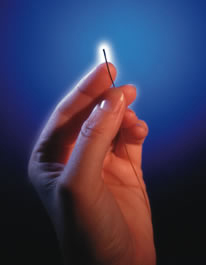
Best Medical Canada, through CNMC Company, offers three different styles of MOSFET dosimeters. With each of these dosimeters are also options that can be selected. All our dosimeters have the same unique features:
- One calibration factor for all photon and electron modalities in the radiotherapy energy range
- Isotropic (±3% or better for 360°)
- Active region of 0.2 x 0.2mm
- Permits pinpoint measurement without patient shielding
- Dose-rate and temperature independent
- Unobtrusive in procedures
- Lightweight and flexible
- Multiple dosimeter capability with one reader
TLD
Model 3500

Manual TLD Reader
The Model 3500 TLD reader provides a cost-effective method for measurement of absorbed radiation dose by use of TLD chips, rods, microcubes or powders. The instrument includes a sample change drawer for inserting and removing the TLD elements, a thermoelectrically cooled photomultiplier tube with associated data acquisition circuits for reading the light emitted by the TLD element and a linear, programmable element heating system. A separate computer with application software performs all other functions, including user interface, acquisition and storage and retrieval of TLD data. The computer may be any Pentium unit operating on any Windows®system.
The 3500 is intended for use in medical physics and other laboratory applications where TLD chips, rods, cubes or powder are employed and required throughput is not high enough to justify an automated reader.
Maximum functionality is achieved at minimum cost by including only the TLD related functions such as sample changer, heating system, thermally cooled photomultiplier tube assembly and supporting data acquisition system, light source, nitrogen connector, start/stop button and power on/off switch. A separate computer performs all other functions. This enables the user to minimize the initial investment in a TLD reader.
A user-provided IBM PC-compatible computer using a Windows®operating system provides main and setup menus, read calibration, dosimeter calibration, batch and dosimeter ID, high voltage adjustment, regions of interest, heating profile, glow curve generation and display, current integral and dose, date and time, background subtract and limits, maintenance menu, high and low dose setting and alarms, reference test light and dark current limits, reader QA procedures, provision for manual element ID entry, provision for manual comment entry, and file maintenance records.
Annealing Ovens
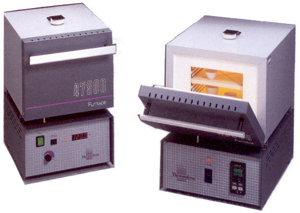
for Thermoluminescence Dosimetry
Choose from three different temperature controller models and two heating chamber dimensions to fit your exact needs. If a single temperature setting is all you need, than choose the Model TL-925 or TL-925-35 with a single setpoint automatic control. If programmability is desired, choose TL-925-80 or TL-925-835 allowing you to select up to four ramps and four dwells, while Models TL-955 and TL-955-35 allow you to select up to eight ramps and eight dwells, plus offering you an RS-232 communication link.
All models offer fast heat with a minimum temperature gradient through the use of open coil heating elements on both sides of the chamber. Maximum heating efficiency is achieved through the use of thermal-efficient ceramic insulation surrounding the chamber. Preventing heat loss around the door has been achieved by using a free-floating ceramic fiber door, including a chamber plug that totally seals when the spring-loaded door is closed. A door safety interlock switch is provided to disconnect power to the heating elements whenever the door is opened to provide increased operator safety. Removal of undesirable contaminants and moisture is made easy by means of the built-in venting system. Injection of special atmospheres or the monitoring of chamber temperature with an independent measuring device is made easy by using the 3/9" diameter port located at the rear of the chamber.
All controls are equipped with a dual fluorescent display of both the actual and the setpoint temperature values. The top display indicates the actual temperature measured by the thermocouple. The bottom display shows the setpoint temperature selected by the operator.
Programmable temperature controls give the operator the ability to expand the capabilities of a single oven. The operator can program the rate of temperature rise or fall (RAMP), and the period that the temperature holds at a specific level (DWELL), both at different temperature levels. RAMP rate is programmable in degrees per minute and the DWELL periods in increments of 0.1 to 999.9 minutes. Controls also feature a "Holdback" function. If the oven is not able to heat or cool at the rate that has been programmed, the program will stop and wait for the temperature to catch up.
All models come complete with an on/off switch, thermocouple and grounded three-wire cord and plug. 220V 50/60Hz models are available on special order.
Thermoluminescence Dosimetry

Materials
Lithium Fluoride finds use in medical physics dosimetry due to its effective atomic number of 8.2, negligible fading and usable range from a few mR to 500R. Standard response is ±30% per batch.
Lithium Fluoride, High Sensitivity – High sensitivity manganese, copper and phosphorous doped LiF dosimeters exhibit the same desirable properties as TLD-100, but feature sensitivity 15 times greater. Standard response is ±15% per batch.
Calcium Fluoride – Dysprosium-activated calcium fluoride dosimeters exhibit sensitivity 30 times greater than lithium fluoride (TLD-100) and three times that of manganese-activated CaF. They are considered the best material for short-term environmental applications. The effective atomic number for photoelectric absorption is 16.3. Standard response is ±30% per batch.
Aluminum Oxide dosimeters have sensitivity 50 times greater than TLD-100 and an effective atomic number for photoelectric absorption of 10.2. These properties make them well suited for personnel dosimetry applications that require detectability of low radiation levels, low long-term fading and more nearly tissue-equivalent performance than calcium-based materials. Standard response is ±30% per batch.
Thermoluminescence Dosimetry

Accessories
Model TL-758, Vacuum Tweezer System consists of a double-insulated vacuum pump that delivers 355mmHg vacuum at 125 cubic inches per minute, a bypass pick-up probe, inline filter, and five interchangeable pickup tips. The vacuum pump operates on 110 Volts AC (220 Volts also available). TL dosimeter handling with a vacuum pick-up probe is fast, and will not mar, scratch or contaminate crystal surfaces.
Model TW-108, Teflon Tipped Tweezers is specially designed for handling TL dosimeters. Made of stainless steel with smooth, wide, teflon-coated tips that will not mar, scratch or contaminate crystal surfaces.
Easy Transfer Dosimeter Storage Containers provide a convenient means of transfer of TL dosimeters to an annealing planchet or irradiation phantom. Each row of spaces is numbered horizontally and vertically, identifying the dosimeter location. A cover with thumb screw fasteners provides spill-proof and dust-proof storage of TL dosimeters.
To transfer TL dosimeters to the planchet or irradiation phantom, line up the numbers, fasten together with screws and turn over. To store dosimeters, the procedure is reversed.
Irradiation Phantoms are available in polystyrene for insertion in a 25 x 25cm polystyrene stack. Plastic Water® and Solid Water® are available for insertion in a 30 x 30cm stack. Dosimeter space and numbering patterns are mirror images of corresponding storage containers for convenient transfer of dosimeters.
Anodized Aluminum Annealing Planchets measure 10 x 12 x 0.63mm; compact enough to fit heating chambers of TL-925/955 Annealing Ovens.
Model 159-000 has 50 machined spaces measuring 3.1 x 3.1 x 8.2mm to accommodate up to 50 rod dosimeters.
Model 163-000 has 100 machined spaces, 5.4mm diameter, 4.5mm deep, to accommodate ribbon or disk dosimeters. The dosimeters lie flat and in good thermal contact, allowing rapid heat transfer. Dosimeter space and numbering patterns are mirror images of corresponding storage containers for convenient transfer of dosimeters. An acrylic cover with two thumb screws securely retains dosimeters in their location after cool down.
The vacuum tweezers are especially recommended for placing dosimeters in the planchet. To clean the spaces, use cotton swabs, dry or with methanol.
Model 163-002, Planchet Handle – Stainless steel handle inserts into a heating planchet to provide safe handling of hot planchets when being removed from the annealing oven.
Model 164-000, Brass Cooling Plates – The cool down of annealing planchets is greatly accelerated when sandwiched between this set of two brass plates. Each plate measures 15.2 x 15.2 x 2.5cm, and weighs 11 lbs. This mass provides ample thermal storage capacity and the high thermal conductivity of brass provides fast heat transfer from the planchets. One plate has a large heavy-duty handle attached.
